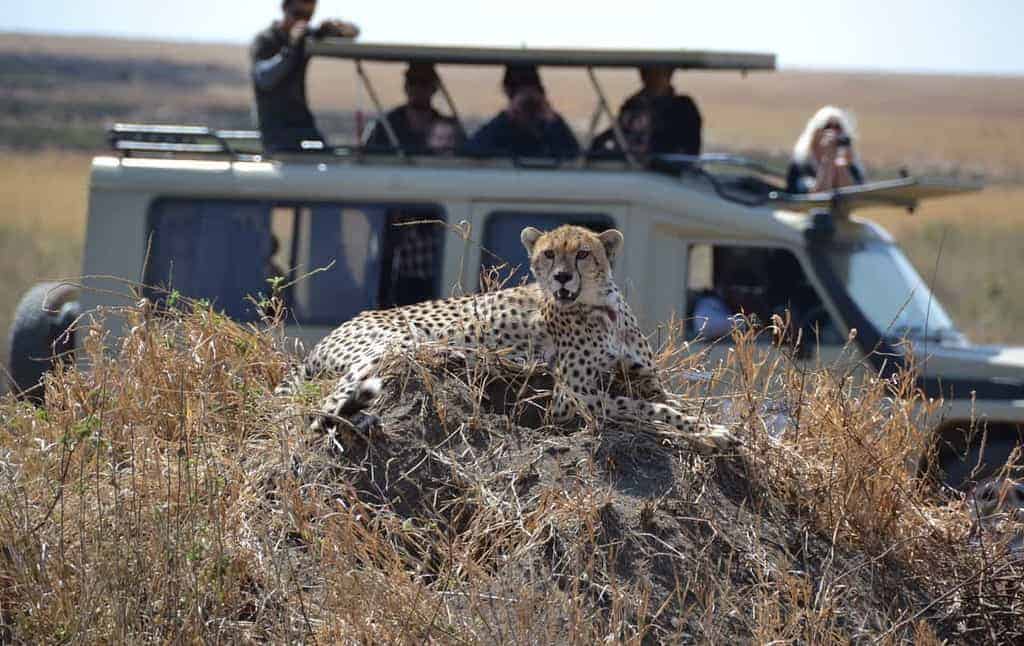7 Day Itinerary: Tanzania Safari
Breathe in the earthy scents of the great African wilderness as you pursue wildlife sightings on this 7 day Tanzania itinerary that takes you through 3 of the country’s national parks. Tanzania, famously known for being the home to the Serengeti National Park and Africa’s highest mountain, Mount Kilimanjaro, is supreme ground for wildlife encounters.
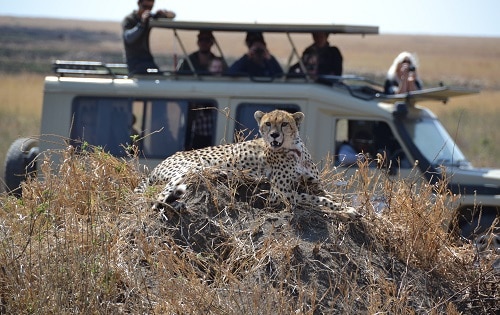
Tanzania hosts the Great Migration, the world’s largest and longest annual terrestrial mammal migration. An estimated ~1.5 million wildebeests accompanied by hundreds of thousands of zebras and antelopes stretch out into the vast horizon traveling north to the Maasai Mara in Kenya relentlessly searching for food and water. Predators, such as lions, leopards, cheetahs, and hyenas, lurk in the background, often hidden by the tall blades of the dry beige-colored grass. Staring upon the vast and seemingly endless plains of the Serengeti is overwhelming. The bountiful wildlife roaming the perpetual grasslands adds to the sensation.
When to Visit Tanzania
Wildlife viewings are always plentiful. Anytime between June and October, the long dry season, offers optimal wildlife sightings. While the exact timing can never be guaranteed as you are in search of wildlife, June and July are the best months to visit the Serengeti National Park to witness the wildebeest migration.
If you visit the Serengeti National Park mid-to-late August, you may not see many of the migratory animals as they may have already migrated north to Kenya. During my visits to the Serengeti National Park in late August/early September on two separate trips three years apart, we saw only a few zebras and only one wildebeest. While the migratory pattern is fairly predictable, the exact timing can never be guaranteed.
If you’re planning your trip around seeing the migratory animals cross the Mara River in Maasai Mara, Kenya, I’d recommend visiting Tanzania in late August and then picking up on Winetraveler’s recommended 7 day Kenya safari itinerary. This itinerary is also a great add-on for hiking enthusiasts venturing to Tanzania to hike Mount Kilimanjaro.
I’d love to return to the Serengeti around February to witness the wildebeest calving season when an estimated 8,000 calves are born each day.
Heavy rains may interfere with your trip if you’re visiting from March through May.
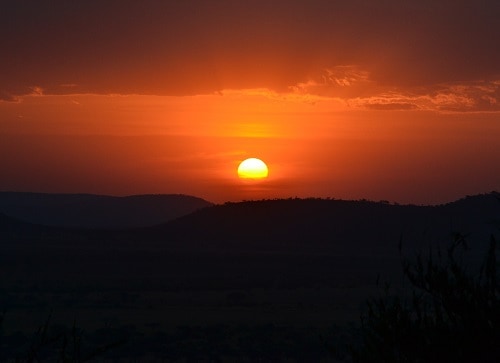
Select a Tour Operator
Selecting a reputable tour operator with experienced guides will maximize your safari experience. There are many companies to choose from at a wide range of price points. Earthlife Expeditions is a popular safari choice for those looking for a private and customizable trip with a mix of luxury and affordability and has received hundreds of 5-star reviews. Visit the Serengeti, Tarangire, Ngorongoro and Lake Manyara National Parks led by an engaging guide. Depending how much you’re looking to spend, accommodation options can be tailored to your budget. Price range per person can range between ~$1000-$3600 for multi-day trips. Everything is included, including hotel pickup and drop-off, meals, etc. For safety, a professional safari guide and AMREF flying doctor coverage is also included.
Another similar option that offers fully customizable luxury or camping options is Rede Tours. Extremely highly-rated and led by passionate guides, with options to visit Arusha, Lake Manyara, Tarangire, Serengeti and Ngorongoro National Parks.
Big Five offers unforgettable trips that are luxurious and adventure-packed. The average price range of their Tanzania tours presently range from ~$700-$3,000 per person per day. Our Tanzanian guide with Big Five was excellent, brilliant at bringing us within arms’ reach to plentiful wildlife, extremely knowledgeable about the wildlife and his country, and his excited energy was contagious.
Peak Planet, the outfitter that guided us up Mount Kilimanjaro and exceeded all of our expectations, offers safaris in Tanzania ranging from 1 to 6 days. Peak Planet’s 6 day luxury tour option is presently listed at $3,560 per person for double occupancy. Park fees, hotel pickup/drop off, lodging, safari vehicle, guide, and meals are all included.
Getting To and Around Tanzania
Fly into the Kilimanjaro International Airport (JRO) and then drive to Arusha. Checking flights to Nairobi and then transferring to Arusha may be worthwhile as flights to Nairobi are often cheaper. We recommend arranging a private transfer ahead of time. Alternatively, you can rent a car. Browse and compare flight deals on Kayak.
The day-to-day driving in the parks and transferring you between parks is in safari vehicles driven by experienced guides, depending on the tour operator you choose that we mentioned above.
From the Serengeti National Park, where this itinerary concludes, you can either continue onward to Kenya, or transfer back to Arusha to return home or continue onward to other adventures. If you’re returning back to Arusha, taking a small charter plane with The Flying Safari Company may be preferable as the drive back to Arusha is ~6 hours. If you intend to drive back, consider saving Ngorongoro Crater for the last stop to break up the driving
First Stop: Arusha (1 Night)
Where to Stay in Arusha
The luxurious Arusha Serena Hotel Resort & Spa, a former coffee farm during colonial times, is nestled within tropical forests, gardens, and at the edge of Lake Duluti. The huts are made of large concrete gray blocks with rounded triangular-shaped thatched layered roofs and triangular entry archways leading into each individual room. Lakeside dining is available.
Another hotel option to consider is Elewana Arusha Coffee Lodge.
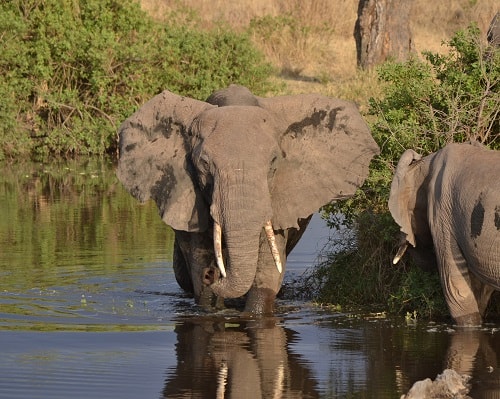
Second Stop: Lake Manyara (1 Night)
Lake Manyara National Park is a great first stop offering an introduction to African safaris on your way to Ngorongoro Crater and the Serengeti. It is a smaller park with a large saltwater lake, green forestry, grasslands, and acacia trees, tree-climbing lions, hippos, a large elephant population, abundant birdlife of over 300+ species, huge flocks of pink flamingos, and boasts having the world’s largest concentration of baboons.
The numerous pink flamingos, while seen from a distance, made the lake appear to have patches and streaks of pink. We easily came across hundreds of baboons sporting large canine teeth and hairless bottoms traveling in troops of 40-50. Tiny baby baboons clench onto the mother’s fur underneath her tummy, and then ride on top of her back as they get older.
Other notable commonly seen animals include zebras, giraffes, warthogs, wildebeests, buffaloes, hippos, impalas, and gazelles. Leopards and especially cheetahs are rarely seen.
Where to Stay by Lake Manyara
The idyllic Lake Manyara Serena Safari Lodge, at an altitude of over 4,600 ft. above sea level, sits high above Lake Manyara with views of the Great Rift Valley. The rooms are in 2-story circular towers with rounded triangular-shaped thatched roofs and balconies overlooking the park. The inviting swimming pool is near the bar, which had live local entertainment during our stay. A bush dining experience is available, and an experience I recommend at least once during your safari trip.
Third Stop: Ngorongoro Crater (2 nights)
Ngorongoro Crater, a once massive volcanic mountain, turned into the world’s largest intact and unfilled caldera upon its collapse. The caldera, a UNESCO World Heritage Site, creates a natural barrier preventing many of the estimated 25,000+ animals inhabiting the area from leaving. The steep forested rim plunges ~2,000 ft. down to an expansive crater floor encompassing an area of ~102 square miles.
Abundant wildlife populate the flat grasslands of the crater and it’s possible to see the Big Five (lion, elephant, Cape buffalo, leopard, and rhinoceros). Lionesses may be seen lazily laying in the road or underneath the shade of a tree, stretching, yawning, and licking the red blood staining the fur around their mouths. Lionesses and cheetahs are often seen stalking gazelles. Seeing a kill is less common to witness, but it’s exciting to sit there in anticipation and maybe watch a chase.
Warthogs, gazelles, zebras, and herds of buffalo and wildebeests graze. Elephants, hippos, ostriches, jackals, and hyenas are also common. Over 500 species of birds have been recorded. Black rhinos may be spotted, but are rare. We saw one far in the distance, but it was so far, it appeared no larger than a speck without binoculars. Giraffes are rarely seen in the crater.
Where to Stay in Ngorongoro Crater
Ngorongoro Sopa Lodge is situated high above the crater at 7,800 ft. above sea level with rooms stretching out along the crater’s rim. The rooms feature a large private enclosed veranda complete with rocking chairs and ceiling-to-floor bay windows overlooking the magical world enclosed within Ngorongoro Crater. The furnishings appeared a tad dated, but the room was spotless, comfortable, and spacious. The most memorable feature of the lodge during our visit was having numerous blue monkeys playfully wandering around. They were everywhere and climbed on everything.
Winetraveler Tip: Bring a warm sweater, jacket, or both as it gets cold at the top of Ngorongoro Crater. I was not prepared for the cold mornings and evenings, which were in the low 40s°F during our trip in late August.
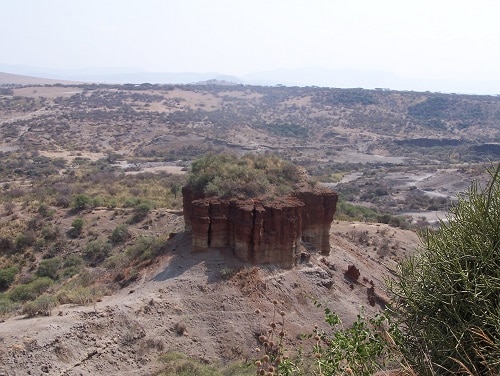
Fourth Stop: Olduvai Gorge
Drive back in time to the Stone Age by visiting the famous archaeological site and small stone museum at the Olduvai Gorge dedicated to Louis and Mary Leakey’s discoveries of the earliest humans.
Fifth Stop: Serengeti National Park (2 nights)
Serengeti National Park, a UNESCO World Heritage Site, is Tanzania’s oldest national park and is quite possibly Africa’s most famous park since the astonishing annual migration takes place here. The expansive park spans 5,695 square miles and is home to the Big Five along with numerous other animals.
Winetraveler Tip: At the entrance to the Serengeti where there is a picnic area and bathrooms, there is a very short uphill trail that offers breathtaking panoramic views of the vast and seemingly endless plains of the Serengeti. The name Serengeti meaning “Endless Plains” is perfectly fitting.
Sporadic, often lone, acacia trees stand out along the vast expansive savannas and grasslands. Lions, cheetahs, elephants, giraffes, zebras, wildebeests, buffaloes, hyenas, gazelles, and topis are common. Leopards are hard to spot, but they are there. Black rhinos are extremely rare to see. With 500+ bird species, it’s a paradise for bird lovers.
It’s believed the Serengeti hosts Africa’s largest population of lions. We came across more lions and prides than I could track, several cheetahs often seen in pairs, and a leopard walked right in front of vehicle while the remains of her hunted gazelle hung down from a nearby tree. Most of these sightings were within arms’ reach. Watching the big cats interact, stretch, play, sleep, and eat reminded me of ordinary household cats just in larger sizes.
Herds of powerful and majestic elephants ranging from ~20 to 70 are often seen crossing the road with the baby elephants sheltered in the middle.
There is a hippo pool where over 100 hippos huddle closely together. The odor is repugnant, but watching their interactions is hypnotizing. Undisturbed hippos appear so calm, it’s hard to imagine they are one of the deadliest animals in Africa to humans, until you see them scare off large crocodiles. The immense power in their jaw is instantly evident when they open their mouths widely revealing their large lower canine teeth. They are known to be able to snap canoes in half.
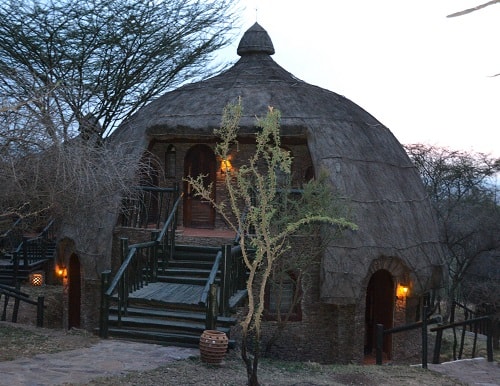
Where to Stay in the Serengeti
The Serengeti Serena Lodge, easily my favorite of our Tanzanian lodges, sits at 4,859 ft. above sea level. The rounded stone lodges feature private balconies, conical thatched roofs and spacious interiors furnished with beautiful African-style décor. Its location up on a hill offers expansive views of the Serengeti and the wandering wildlife. The pool deck is the perfect place to soak in an enchanting African sunset while sipping on a glass of wine or enjoy mimosas served with breakfast.
Winetraveler Tip: Travelers desiring to splurge on an ultra-luxurious accommodation, check out One Nature Nyaruswiga Serengeti.
You can read more and get inspired by Lenore’s other adventurous travel guides here.
